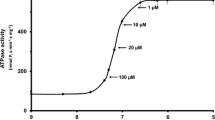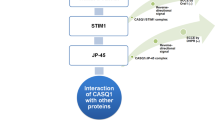Abstract
The present study documents the binding interaction of skeletal muscle sarcoplasmic reticulum (SR) transmembrane protein triadin with peripheral histidine-rich, Ca2+-binding protein (HCP). In addition to providing further evidence that HCP coenriches with RyR1, FKBP-12, triadin and calsequestrin (CS) in sucrose-density-purified TC vesicles, using specific polyclonal antibody, we show it to be expressed as a single protein species, both in fast-twitch and slow-twitch fibers, and to identically localize to the I-band. Colocalization of HCP and triadin at junctional triads is supported by the overlapping staining pattern using monoclonal antibodies to triadin. We show a specific binding interaction between digoxigenin-HCP and triadin, using ligand blot techniques. The importance of this finding is strengthened by the similarities in binding affinity and in Ca2+ dependence, (0.1–1 mM Ca2+) of the interaction of digoxigenin-HCP with immobilized TC vesicles. Suggesting that triadin dually interacts with HCP and with CS, at distinct sites, we have found that triadin-CS interaction in overlays does not require the presence of Ca2+. Consistent with the binding of CS to triadin luminal domain (Guo and Campbell, 1995), we show that binding sites for digoxigenin-CS, although not binding sites for digoxigenin-HCP, can be recovered in the 92 kDa triadin fragment, after chymotryptic cleavage of the NH2-terminal end of the folded molecule in intact TC vesicles. These differential effects form the basis for the hypothesis that HCP anchors to the junctional membrane domain of the SR, through binding to triadin short cytoplasmic domain at the NH2 terminus. Although the function of this interaction, as such, is not well understood, it seems of potential biological interest within the more general context of the structural-functional role of triadin at the triadic junction in skeletal muscle.
Similar content being viewed by others
References
Biral D, Damiani E, Volpe P, Salviati G and Margreth A (1982) Polymorphism of myosin light chains. Biochem J 203: 529-540.
Biral D, Volpe P, Damiani E and Margreth A (1991) Coexistence of two Calsequestrin isoforms in rabbit slow-twitch skeletal muscle fibers. FEBS Lett 299: 175-178.
Brandt NR, Caswell AH, Brunschwig JP, Kang JJ, Antoniu B and Ikemoto N (1992) Effects of anti-triadin antibody on Ca2+ release from sarcoplasmic reticulum. FEBS Lett 299: 57-59.
Buck E, Nguyen H, Pessah I and Allen P (1997) Dyspedic mouse skeletal muscle expresses major elements of the triadic junction but lacks detectable ryanodine receptor protein and function. J Biol Chem 272: 7360-7367.
Campbell N and Sargent JR (1967) In: Campbell PN and Sargent JR (eds.) Techniques in Protein Biosynthesis. (pp. 299-311). Academic Press, London New York.
Caswell AH, Brandt N, Brunschwig J-P and Purkerson S (1991) Localization and partial characterization of the oligomeric disulfide-linked molecular weight 95000 protein (triadin) which binds to the ryanodine and dihydropyridine receptors in skeletal muscle triadic vesicles. Biochemistry 30: 7507-7513.
Cleveland D, Fischer S, Kirschner M and Laemmli UK (1977) Peptide mapping by limited proteolysis in sodium dodecyl sulphate by gel electrophoresis. J Biol Chem 252: 1102-1106.
Damiani E, Tobaldin G, Volpe P and Margreth A (1991) Quantitation of ryanodine receptor of rabbit skeletal muscle, heart and brain. Biochem Biophys Res Commun 175: 858-865.
Damiani E and Margreth A (1991) Subcellular fractionation to junctional sarcoplasmic reticulum and biochemical characterization of 170 kDa Ca2+-and low-density-lipoprotein-binding protein in rabbit skeletal muscle. Biochem J 277: 825-832.
Damiani E, Tarugi P, Calandra S and Margreth A (1992) Sequential expression during postnatal development of specific markers of junctional and free sarcoplasmic reticulum in chicken pectoralis muscle. Devel Biol 153: 102-111.
Damiani E and Margreth A (1994) Characterization study of the ryanodine receptor and of calsequestrin isoforms of mammalian skeletal muscles in relation to fibre types. J Musc Res Cell Motil 15: 86-101.
Damiani E, Picello E, Saggin L and Margreth A (1995) Identification of triadin and of histidine-rich Ca2+-binding protein as substrates of 60 kDa calmodulin-dependent protein kinase in junctional terminal cisternae of sarcoplasmic reticulum of rabbit fast muscle. Biochem Biophys Res Commun 209: 457-465.
Damiani E, Tobaldin G, Bortoloso E and Margreth A (1997) Functional behaviour of the ryanodine receptor/Ca2+-release channel in vesiculated derivatives of the junctional membrane of terminal cisternae of rabbit fast muscle sarcoplasmic reticulum. Cell Calcium 22: 129-151.
Duggan PF and Martonosi A (1970) The permeability of sarcoplasmic reticulum membranes. J Gen Physiol 56: 147-157.
Fabiato A (1988) Computer programs for calculating total from specified free or free from specified total ionic concentrations in aqueous solution containing multiple metals and ligands. Meth Enzymol 157: 378-401.
Fan H, Brandt N, Peng M, Schwartz A and Caswell A (1995) Binding sites of monoclonal antibodies and dihydropyridine receptor a1 subunit cytoplasmic II-III loop on skeletal muscle triadin fusion peptides. Biochemistry 34: 14893-14901.
Flucher B and Franzini-Armstrong C (1996) Formation of junctions involved in excitation-contraction coupling in skeletal and cardiac muscle. Proc Natl Acad Sci USA 93: 8101-8106.
Franzini-Armstrong C, Pincon-Raymond M and Rieger F (1991) Muscle fibers from dysgenic mouse in vivo lack a surface component of periferal coupling. Devel Biol 146: 364-376.
Guo W, Jorgensen A, Jones L and Campbell KP (1996) Biochemical characterization and molecular cloning of cardiac triadin. J Biol Chem 271: 458-465.
Guo W and Campbell KP (1995) Association of triadin with the ryanodine receptor and calsequestrin in the lumen of the sarcoplasmic reticulum. J Biol Chem 270: 9027-9030.
Hofmann SL, Brown MS, Lee E, Pathak RK, Anderson R and Goldstein JL (1989a) Purification of a sarcoplasmic reticulum protein that binds Ca2+ and plasma lipoproteins. J Biol Chem 264: 8260-8270.
Hofmann SL, Goldstein JL, Orth K, Moomaw CR, Slaughter CA and Brown MS (1989b) Molecular cloning of a histidine-rich Ca2+-binding protein of sarcoplasmic reticulum that contains highly conserved repeated elements. J Biol Chem 264: 18083-18090.
Hofmann S, Topham M, Hsieh C and Francke U (1991) cDNA and genomic cloning of HRC, a human sarcoplasmic reticulum protein, and localization of the gene to human chromosome 19 and mouse chromosome 7. Genomics 9: 656-669.
Horgan DJ and Kuypers R (1988) Biochemical properties of purified transverse tubules isolated from skeletal muscle triads. Arch Biochem Biophys 260: 1-9.
Jayaraman T, Brillantes A-M, Timerman A, Fleischer S, Erdyiument-Bromage H, Tempst P and Marks A (1992) FK506-binding protein 414 associated with the Ca2+-release channel (ryanodine receptor). J Biol Chem 267: 9474-9477.
Jorgensen AO, Kalnins V and MacLennan D (1979) Localization of sarcoplasmic reticulum proteins in rat skeletal muscle by immunofluorescence. J Cell Biol 80: 372-384.
Jones PD and Wakil S (1967) A requirement for phospholipids by the microsomal reduced diphosphopyridine nucleotide-cytochrome c reductase. J Biol Chem 242: 5267-5273.
Jones LR, Zhang L, Sanborn K, Jorgensen A and Kelley J (1995) Purification, primary structure and immunological characterization of the 26 kDa calsequestrin binding protein (Junctin) from cardiac sarcoplasmic reticulum. J Biol Chem 270: 30787-30796.
Kim K, Caswell A, Talvenheimo J and Brandt R (1990) Isolation of a terminal cisterna protein which may link the dihydropyridine receptor to the junctional foot protein in skeletal muscle. Biochemistry 29: 9281-9289.
Knudson CM, Stang KK, Jorgensen A and Campbell KP (1993a) Biochemical characterization and ultrastructural localization of a major junctional sarcoplasmic reticulum glycoprotein (triadin). J Biol Chem 268: 12637-12645.
Knudson CM, Stang KK, Moomaw CR, Slaughter CA and Campbell KP (1993b) Primary structure and topological analysis of a skeletal muscle-specific junctional sarcoplasmic glycoprotein (triadin). J Biol Chem 268: 12646-12654.
Laemmli UK (1970) Cleavage of structural protein during the assembly of the head of bacteriophage. Nature 277: 680-685.
Lewis Carl S, Felix K, Caswell AH, Brandt NR, Brunschwig JP, Meissner G and Ferguson DG (1995) Immunolocalization of triadin, DHP receptors, and ryanodine receptors in adult and developing skeletal muscle of rats. Muscle Nerve 18: 1232-1243.
Liu G and Pessah I (1994) Molecular interaction between ryanodine receptor and glycoprotein triadin involves redox cycling of functionally important hyperreactive sulfhydryls. J Biol Chem 269: 33028-33034.
Lowry OH, Rosebrough NJ, Farr AL and Randall RJ (1951) Protein measurements with the Folin phenol reagent. J Biol Chem 193: 265-275.
Marty I, Robert M, Ronjat M, Bally I, Arlaud G and Villaz M (1995) Localization of the N-terminal and C-terminal ends of triadin with respect to the sarcoplasmic reticulum membrane of rabbit skeletal muscle. Biochem J 307: 769-774.
Marx SO, Ondrias K and Marks AR (1998) Coupled gating between individual skeletal muscle Ca2+ release channels (ryanodine receptors). Science 281: 818-821.
Ohkura M, Furukawa K-I, Fujimori H, Kuruma A, Kawano S, Hiraoka M, Kuniyasu A, Nakayama H and Ohizumi Y (1998) Dual regulation of the skeletal muscle ryanodine receptor by triadin and calsequestrin. Biochemistry 37: 12987-12993.
Pathak RK, Anderson RGW and Hofmann SL (1992) Histidine-rich calcium binding protein, a sarcoplasmic reticulum protein of striated muscle, is also abundant in arteriolar smooth muscle cells. J Muscle Res Cell Motil 13: 366-376.
Picello E, Damiani E and Margreth A (1992) Low-affinity Ca2+-binding sites versus Zn2+-binding sites in histidine-rich Ca2+-binding protein of skeletal muscle sarcoplasmic reticulum. Biochem Biophys Res Commun 186: 659-667.
Raeymaekers L, Verbist J, Wuytack F, Plessers L and Casteels R (1993) Expression of Ca2+ binding proteins of the sarcoplasmic reticulum of striated muscle in the endoplasmic reticulum of pig smooth muscles. Cell Calcium 14: 581-589.
Sabbadini RA and Okamoto VR (1983) The distribution of ATPase activities in purified transverse tubular membranes. Arch Biochem Biophys 223: 107-119.
Sacchetto R, Volpe P, Damiani E and Margreth A (1993) Postnatal development of rabbit fast-twitch skeletal muscle: accumulation, isoform transition and fiber distribution of calsequestrin. J Muscle Res Cell Motil 14: 646-653.
Sacchetto R, Margreth A, Pelosi M and Carafoli E (1996) Colocalization of the dihydropyridine receptor, the plasma-membrane calcium ATPase isoform 1 and the sodium/calcium exchanger to the junction-membrane domain of transverse tubules of rabbit skeletal muscle. Eur J Biochem 237: 483-488.
Saito A, Seiler S, Chu A and Fleischer S (1984) Preparation and morphology of sarcoplasmic reticulum terminal cisternae from rabbit skeletal muscle. J Cell Biol 99: 875-885.
Salvatori S, Damiani E, Barhanin J, Furlan S, Salviati G and Margreth A (1990) Co-localization of the dihydropyridine receptor and the cyclic AMP-binding subunit of an intrinsic protein kinase to the junctional membrane of the transverse tubules of skeletal muscle. Biochem J 267: 679-687.
Shoshan-Barmatz V, Orr I, Weil S, Meyer H, Varsanyi M and Heilmeyer LMG (1996) The identification of the phosphorylated 150/160-kDa proteins of sarcoplasmic reticulum, their kinase and their association with the ryanodine receptor. Biochim Biophys Acta 1283: 89-100.
Sutko JL and Airey JA (1996) Ryanodine receptor Ca2+ release channels: does diversity in form equal diversity in funcions? Physiol Rev 76: 1027-1071.
Takekura H, Nishi M, Neda T, Takeshima H and Franzini-Armstrong C (1995) Abnormal junctions between surface membrane and sarcoplasmic reticulum in skeletal muscle with a mutation targeted to the ryanodine receptor. Proc Natl Acad Sci USA 92: 3381-3385.
Towbin H, Staehelin T and Gordon J (1979) Electrophoretic transfer of protein from polyacrylamide gels to nitrocellulose sheets: procedure and some applications. Proc Natl Acad Sci USA 76: 4350-4354.
Zhang L, Kelley J, Schmeisser G, Kobayashi Y and Jones L (1997) Complex formation beteen junctin, triadin, calsequestrin and the ryanodine receptor. J Biol Chem 272: 23389-23397.
Zorzato F and Volpe P (1988) Calcium binding proteins of junctional sarcoplasmic reticulum. Arch Biochem Biophys 261: 324-329.
Author information
Authors and Affiliations
Rights and permissions
About this article
Cite this article
Sacchetto, R., Turcato, F., Damiani, E. et al. Interaction of triadin with histidine-rich Ca2+-binding protein at the triadic junction in skeletal muscle fibers. J Muscle Res Cell Motil 20, 403–415 (1999). https://doi.org/10.1023/A:1005580609414
Issue Date:
DOI: https://doi.org/10.1023/A:1005580609414




